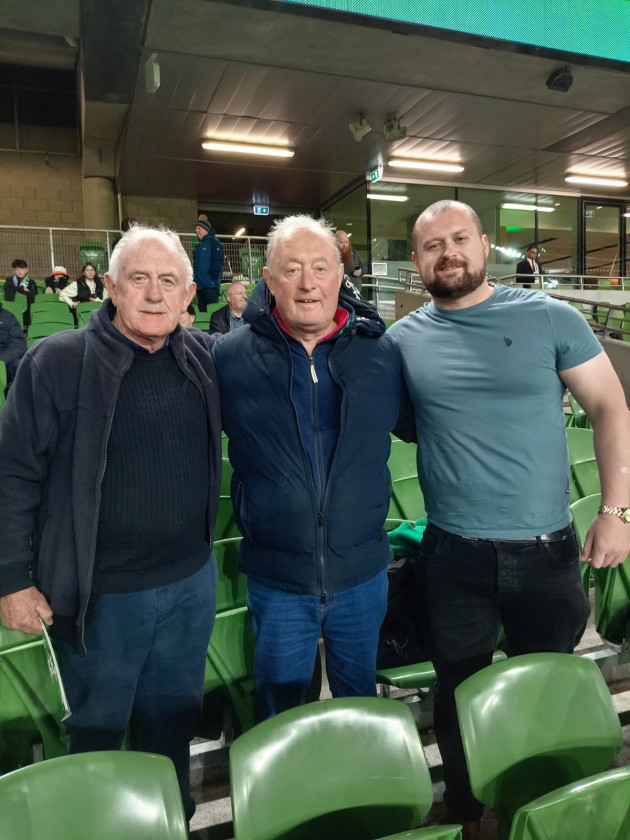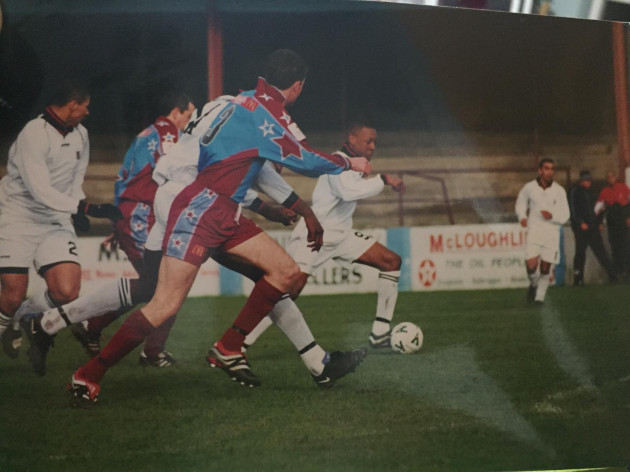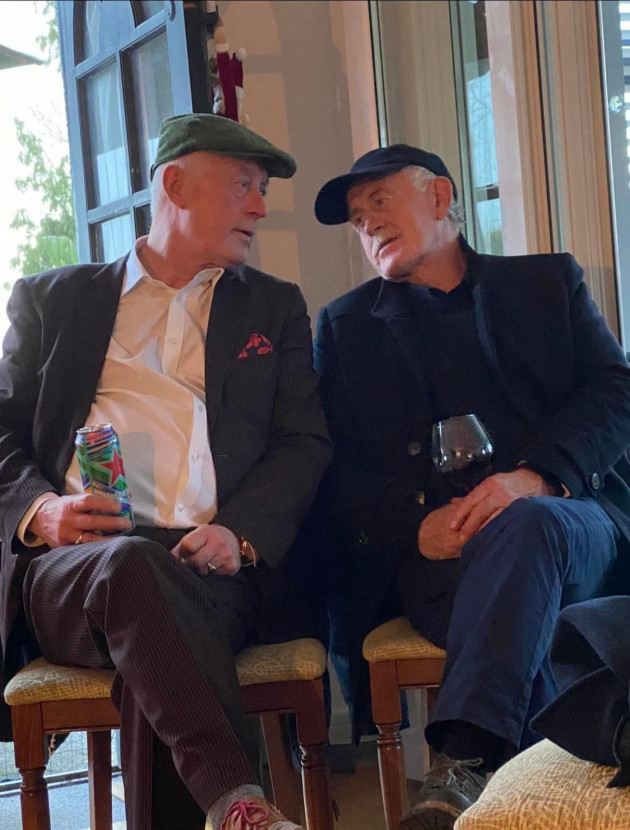IRELAND IS often described as a sports-mad nation and you would be hard-pressed to find anyone in the country more passionate than the late Jim Moore.
Born in Galway, he moved with the rest of his family to Mullingar in 1964.
Like his four brothers, Moore was interested in a range of sports. He was part of the Downs team that played in five county finals, winning two of them and was a centre-back with Mullingar Town soccer team for many years, helping them win the FAI Junior Cup Midlands Area in 1986 and 1987, and playing in seven finals overall.
In 1964, he watched his native Galway beat Kerry in the All-Ireland Senior Football Championship final, and he attended every subsequent All-Ireland final until 2020 when Covid meant the game had to be played without fans in attendance. His appearance at the 2014 Croke Park decider between Kerry and Donegal meant he had made it to 50 finals on the bounce, including replays.
Moore sponsored many teams in Ireland over the years, including Westmeath GAA. He was also an avid follower of the Irish football team, frequently attending home matches, while he was planning to go to the latest Rugby World Cup before falling ill.
His interest in cricket and rugby became stronger when he moved to London in 1988 for his job as a chartered surveyor where he was involved in several high-profile sporting projects, including the redevelopment of Wembley Stadium and the 2012 Olympics.
But perhaps Moore’s most famous association with sport is when he spearheaded a bid to bring League of Ireland football to Mullingar.
The idea first came ahead of the 2001-02 season. St Francis’ withdrawal meant there was a vacancy in the First Division.
Playing in the League of Ireland had its benefits. In the early 1990s amid the onset of the Premier League, Sky paid 22 League of Ireland clubs £1.5 million equally to alleviate threats of a TV blackout in Ireland.
It meant clubs could install floodlights and matches were moved from their usual Sunday afternoon slot to Friday nights.
St Francis lasted only five seasons in the League of Ireland but they got their floodlights on the back of joining.
Martin Moore, Jim’s brother who was chairman of Mullingar Town, enquired about his team filling the vacancy and was encouraged to apply by Michael Hyland, the chairman of the Eircom League then.
Several other teams were interested, including Park Villa from Navan, Killarney Celtic, Newbridge Town and Letterkenny Rovers.
Jim Moore flew in from England to join Martin and a delegation from Mullingar to meet FAI officials at the association’s offices in Merrion Square, Dublin.
At the time, Jim’s two young sons were playing in the London Soccer Academy. Joseph De Graft, chairman of the academy, liked the idea and joined Jim on the trip to Dublin.
One of the primary dilemmas, alluded to by Hyland, was that the team were playing in Division 1B of the Leinster Senior League. The sudden jump to League of Ireland football would surely be too great.
That’s when Jim outlined his grand plan. He would send over a team of players from the London Soccer Academy who would view the League of Ireland as the ideal launching pad for a career in professional football.
Moore had amassed considerable wealth, starting his building firm Scanmoor Construction with Mayo-born colleague Tom Scanlon in 1995, and was confident he could fund the operation.
He agreed to put players up in two houses in Mullingar (they eventually rented three and planned to buy them all).
“We called it ‘the Big Brother house,’” Martin Moore tells The 42. “That was the name of the first one. There was one house you could fit the whole lot of them in. But the lady who owned the house said ‘I only want 10 here’. So he rented another house and put six or seven into it.”
The delegation went for a tea break and by the time they returned to the FAI’s offices, several League of Ireland representatives had joined Hyland in the meeting.
According to Martin Moore, they were warned that Shelbourne had lost £1 million, despite recently winning the Premier Division title and competing in the Champions League qualifying rounds. Meanwhile, “the worst team in Ireland” had lost £150,000 (Ireland’s currency didn’t officially change to euros until a few months later).
The message was clear — joining the League of Ireland was not a prudent financial move.
Yet Jim was not put off. In addition to housing the players, he pledged to pay them each £50 a week. He would also feed them by employing a chef to cook daily and facilitate full-time training.
“They were in Buckley’s supermarket in Mullingar with two big trolleys. One for each house. And it cost about two grand a month,” Martin Moore adds.
A total of 16 players came over from London — Moore says around 400 originally turned up for trials — in addition to the manager, Leroy Rhodes, a former Brentford player who lives in Mullingar to this day.
Yet their League of Ireland status was not yet secure. Martin Moore felt not everyone who had attended the meeting was overly enthused by the idea and feared the competition from a footballing and commercial perspective, particularly representatives of Athlone and Longford Town, who would have been the teams located closest to Mullingar.
In the end, a compromise was reached. A spot was left vacant in the First Division, with only nine teams competing in the 2001-02 season.
Mullingar would be allowed to compete in the Eircom U21 League initially, with the decision on who would fill the 10th slot in the First Division postponed for a couple of months.
The story created a stir at the time. Just before meeting the players at Dublin Airport, Moore took a call from Joe Duffy and gave his thoughts on the story to RTÉ’s Liveline.
Several newspaper journalists and photographers were also there to greet the players, with the new incarnation of Mullingar nicknamed the ‘Dream Team’.
Explaining the decision to rely primarily on English-based players rather than homegrown talent, Jim Moore told reporters: “All the good players in Ireland are already with Eircom League clubs but there are loads of players in London who would be up to the standard and who are available.”
On his unconventional approach and how he explained it to FAI officials, Moore added: “I told them Mullingar Town was my passion and that I had the money to do it.
“But I’m not in it for the money. I’m a property developer and contractor. If I want to make more money, I’ll make it through property, not football. It’s easy that way.”
Moore’s eventual plan was to create a scheme in Mullingar comparable to the famous Ajax youth system but a strong senior team needed to be established first.
It was a chaotic time not just for Irish football but the world at large — the 9/11 attacks occurred just two weeks after the Mullingar team arrived in Ireland.
The squad included four players of Nigerian descent, one Brazilian and one Palestinian, who Moore says tried out for the Palestine national team and narrowly missed the cut.
A crowd of roughly 600 people attended their first match — a 1-0 home win over Drogheda United.
Behind the scenes, the saga over whether they would gain senior League of Ireland status continued.
Hyland suggested the club merge with local rivals Mullingar Athletic, who promptly rejected the offer.
Every other side who had originally expressed an interest in filling St Francis’ spot had withdrawn apart from Newbridge Town.
Newbridge then became known as Kildare County, ostensibly to enhance the chances of a successful bid and appear more attractive to potential fans and sponsors.
Moore was advised to change his team’s name to Westmeath United or Westmeath County, but declined to do so and felt it would not have made a difference in the long run.
The Sallins-born former Fianna Fáil politician Charlie McCreevy, Minister for Finance at the time, was backing his home county’s bid.
According to Moore, McCreevy argued that Kildare had a population of 150,000 and no League of Ireland club, while there was already one club in Westmeath — Athlone Town.
In early 2002, the two clubs had a chance to make a final case to the FAI.
Before the announcement on 21 February, Eircom League commissioner Roy Dooney rang Jim Moore and told him the bad news — in words that echoed McCreevy’s stance.
Martin Moore remembers: “He said: ‘We have decided to go with Newbridge Town for the reason Kildare have a population of 150,000 and no League of Ireland club.’”
An Irish Times report at the time noted: “With no terracing or stands, the current ground in Newbridge has an estimated capacity of 2,000 and one of the first tasks of the Board of Directors, whose exact make-up has yet to be decided, will be to improve facilities.
“An application has already been made to the Department of Sports and Tourism for funding terraces and floodlights.”
The ‘Dream Team’ continued to play in the Eircom U21 League, hoping another spot would eventually become available in the First Division.
They had some success at underage level, reaching two FAI U21 Cup semi-finals, losing to Waterford and a Cork City side that featured future Ireland international Shane Long.
When some English players grew impatient and decided to move elsewhere, another group were sent over while homegrown footballers were increasingly integrated into the setup.
Eventually, Jim Moore decided to stop sending over players from England.
“He was wasting all the money he had for it because if you’re getting to the League of Ireland fair enough,” says Martin. “But he said: ‘I’ll back a local team until there’s another vacancy.’”
Mullingar Town finally dropped out after the U21 league was scrapped and relaunched as a U20 competition ahead of the 2008 campaign.
“I said it’s not worth our while doing what we’re doing now,” Martin Moore adds. “So that was the end of it.”
Minus the considerable foreign influence, Mullingar Town returned to competing in the Leinster Senior League and remain active at various levels.
Martin Moore claims Kildare County, who withdrew from the League of Ireland after eight seasons, got €400,000 from the FAI.
“So they built a stand and played on an all-weather pitch. If we got the nod, we would have got that money.
“We would have built dressing rooms and a stand.”
None of Mullingar’s English players ever became genuinely famous.
One midfielder, Ashley Sestanovich, later played for Sheffield United and was part of a Scarborough side who were narrowly beaten 1-0 by Claudio Ranieri’s Chelsea in a high-profile 2004 FA Cup tie.
Born in London and of Croatian and Grenadian descent, at one point, Sestanovich took a break from his Mullingar Town duties to spend a weekend in Paris, working as a body double for Thierry Henry in a Nike TV commercial.
But sadly, in December 2006, he was convicted of conspiracy to rob a roofing company before being sentenced to eight years in prison in April 2007.
A handful of other ex-Mullingar footballers went on to play non-league football in England but never got further than that level — although Moore believes at least a couple of the squad were good enough to play for other teams at League of Ireland level “if they wanted to”.
“About 10″ of the players returned to Mullingar and played a friendly match in 2012 and Moore expects they will be back again soon to celebrate 25 years since the ‘Dream Team’ was launched.
The project might ultimately have amounted to an expensive failure. However, it certainly caught people’s imagination on a local and national level, while Jim spoke fondly of the venture when interviewed by the Westmeath Examiner in 2010.
Sadly, he passed away after a long illness last December but still managed to attend one more All-Ireland final in July, the Champions Cup final between Leinster and La Rochelle in May and his last-ever match as a spectator, the Ireland-Greece Euro 2004 qualifier in October.
His brother Martin, meanwhile, remains chairman of Mullingar Town and is celebrating his 69th birthday this month.
The love of sport has also been passed down the generations. Martin’s nephew Conor has become popular and well-known for his impressions of sports stars like Roy Keane and Ronan O’Gara.
Meanwhile, the Dream Team’s League of Ireland ambitions may not have been realised, but their legacy remains.
For example, Martin recounts an anecdote about one player whose life was altered irrevocably by this chance move to Ireland.
“There was a fella called Nadiam Akhtar, he’s of Pakistani [descent], born in England,” he recalls. “His father played against George Best. So we nicknamed him ‘Bestie’. A lot of people around Mullingar know him as ‘Bestie’.
“He went out with a girl in Mullingar, Ann Daly, and married her about three years later. She moved to London when he went back. He trains kids at a soccer academy there. She is a hairdresser. And they have five or six kids now.
“Every time they’re back in Mullingar, they say: ‘Martin, if it weren’t for you and Jim we would never have met.’ And that’s the truth.”






